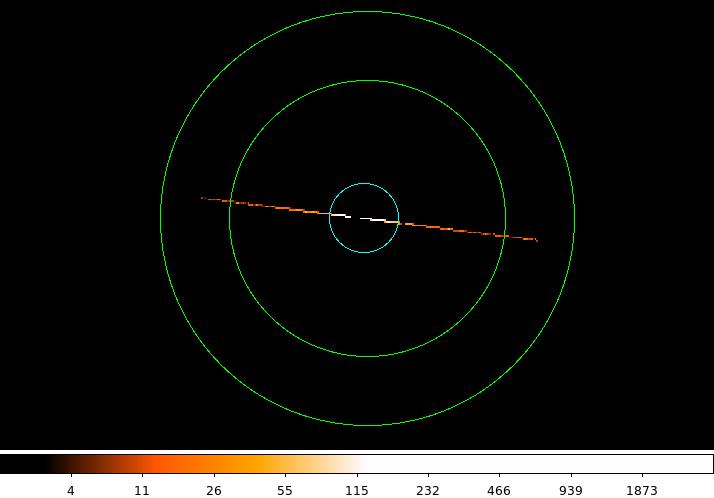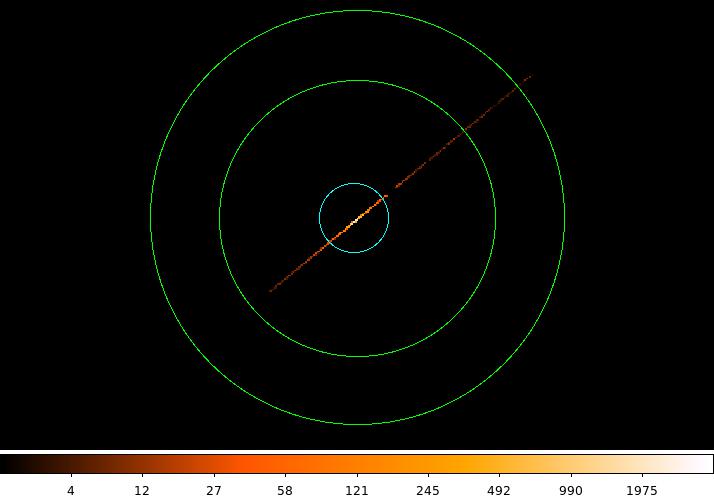- Home
- About
- Support
- Data Access
- Data Analysis
- Data Products
- Publications
-
Links
Databases NED Simbad GCN circulars archive GRB data table Software & Tools Swift Software (HEASoft) Xanadu WebPIMMS Institutional Swift Sites GSFC PSU OAB SSDC MSSL University of Leicester
A comment on the BACKSCAL keyword for Windowed Timing mode
When given a source and background spectrum, XSPEC constructs
a background subtracted spectrum as follows :
Background_subtracted_spectrum (cts/s) = (source_counts/source_exposure)-
[(bgd_counts/bgd_exposure)*(source_backscal/bgd_backscal)]
That is, it scales the background spectrum by the ratio of source_backscal/bgd_backscal before subtracting it, where source_backscal is the BACKSCAL keyword in the spectrum extension of the source spectral file, and bgd_backscal is the BACKSCAL keyword in the background spectral file.
BACKSCAL is defined as the ratio of the detector area from which the source is extracted to the total detector area.
For Windowed Timing (WT) mode, the ratio of BACKSCAL values (which are inserted into a spectral file extracted by XSELECT) will only be correct if your source and background extraction regions are the same radius if you use circles, or the same height if you use boxes. If the extraction regions aren't the same size (or shapes) then it's better if the BACKSCAL values reflect the 1D extent of the extraction region in the DETX coordinate direction (as WT data are essentially 1D, with the DETY dimension collapsed down by the readout process).
For example, if you use a circular region for the source of radius r_s but a different sized circle of radius r_b for the background, then it's better to set the source BACKSCAL to 2 r_s and the background BACKSCAL to 2 r_b (provided, of course, that the background region doesn't extend beyond the end of the WT window where there are no data).
It may be preferable to use an annulus, centred on the source position, for WT background regions, with inner and outer radii = r_1 and r_2, chosen to be symmetrically placed about 100 pixels (the half-width of the WT window) - for example r_1 = 80, r_2 = 120, or r_1 = 70, r_2 = 130, etc - as this ensures that no matter where the source is in the WT window, the background region will contain (r_2 - r_1 - 1) pixels in 1D (minus one, as the end-of-window pixels are flagged as bad by the ground software processing and not available for use. Strictly speaking, if the source is close to the centre of the window and the annulus therefore overlaps both ends of the strip, this should be minus two, while if the annulus doesn't actually enclose the end of the strip, r_2 - r_1 is correct. Plus or minus one pixel makes a negligible difference, though). In this case, the background BACKSCAL should be set to (r_2 - r_1 -1), and the source to 2 r_s (assuming the source region is circular, as before.) Obviously, this is only appropriate if the source is located within the WT window and not near the bad columns.
Note that this is not a problem for the 2D Photon Counting (PC) mode.
Below we show two examples of how such an annulus may appear in two cases: on the left we show an observation when the source was quite well centred in the window. In this case, the annulus includes background counts from both sides of the window. On the right, the source was located close to one end of the window, so all the counts from the annulus are at the opposite end of the strip. In each case, the cyan circle shows the source extraction region (20 pixels radius), while the green annulus (80-120 pixels) demonstrates the background. In both cases, there are 40 pixels of background photons in total.


Please note that, if you have multiple snapshots of data, all taken at the same roll angle, but with the source located at different positions within the window (because of changing spacecraft pointing following each slew), the window strip may appear to be wider than 200 pixels. If you extract an image for a single snapshot, however, this will become clear.
